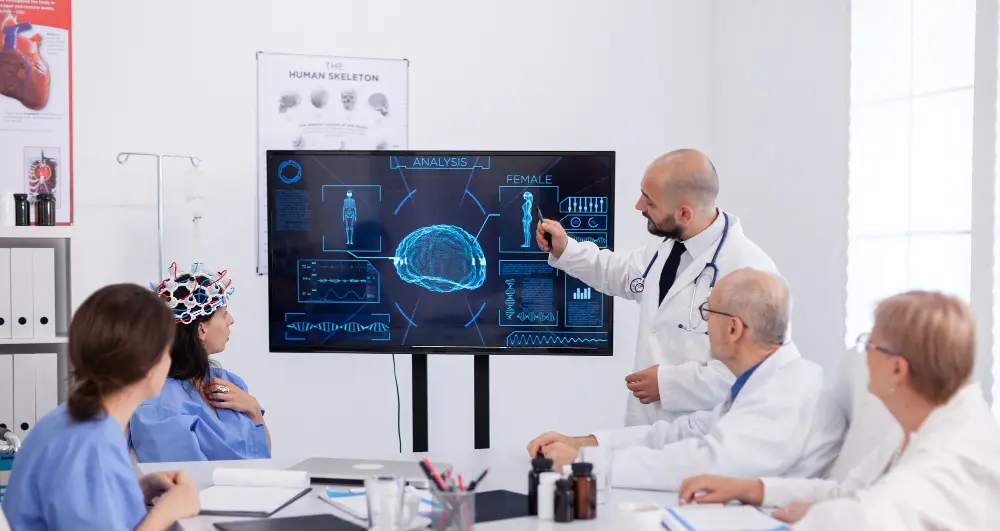•
Sep 19

Sand Technologies
In vast stretches of rural America, the heartbeat of healthcare is fading. Hospitals are closing their doors at an alarming rate, doctors are in short supply and access to even basic specialized care can mean a journey of hundreds of miles.
To address this crisis, the Centers for Medicare and Medicaid Services (CMS) has injected hope into this challenging landscape. CMS has announced the $50 billion Rural Health Transformation Program, a landmark investment aimed at revitalizing the nation’s struggling rural healthcare systems to improve health equity. The CMS program is a clear signal that business as usual is no longer an option. It’s a call for bold, innovative care models.
Where you live
shouldn’t
determine if you live.
But what if the most powerful blueprint for the future of rural healthcare in America doesn’t come from a top U.S. research hospital, but from the sun-drenched, resource-strapped landscapes of a country thousands of miles away?
An innovative care model with AI-enabled and connected clinics presents a compelling option that aligns remarkably well with America’s new vision for rural health. It’s time to examine how this unexpected source of inspiration can offer a powerful and relevant path forward.
One of the most significant barriers to healthcare in rural communities is the shortage of healthcare professionals, as well as limited access to specialized care.
in Rural areas
in Urban areas
The lack of adequate care has devastating impacts, such as higher mortality rates, 50% higher than in urban areas.
Geographic barriers often require residents to travel long distances to access healthcare facilities, resulting in delays or avoidance of necessary treatment. Limited services in some rural hospitals are closing due to financial issues, resulting in reduced availability of in-person and emergency care.
These challenges are tough to overcome due to an underdeveloped public health infrastructure. Frequently underfunded, rural public health departments lack the capacity and resources to meet population health goals. Last, the lack of adequate broadband infrastructure hinders the effective use of telehealth services, which could otherwise improve access to specialists and information in remote areas.
The $50 billion CMS initiative is more than just a financial infusion; it’s a strategic roadmap designed to transform healthcare delivery beyond major urban centers. The program is built on five key pillars, each addressing a critical weakness in the current system.
First, to improve rural health, the approach needs to shift from reactive treatment to proactive, preventative health and tackling the root causes of chronic diseases. Second, it must also include sustainable access, creating a financially viable model that ensures rural clinics and hospitals can remain open in the long term. Third, stakeholders must devise new strategies to attract, train and retain a skilled healthcare workforce in rural communities. Fourth, the solution must include innovative care models that enable rural communities to achieve more with limited resources. This approach should encourage funding new, flexible and patient-centered methods for delivering care. Last, the CMS program promotes technological innovation. Fostering the use of cutting-edge tools, including remote monitoring, data analytics and artificial intelligence, can bridge gaps in access and efficiency.

Shift from reactive treatment to proactive, preventative health and tackling the root causes of chronic diseases.

Sustainable access, creating a financially viable model that ensures rural clinics and hospitals can remain open in the long term.

Devise new strategies to attract, train and retain a skilled healthcare workforce in rural communities.

Innovative care models that enable rural communities to achieve more with limited resources. This approach should encourage funding new, flexible and patient-centered methods for delivering care.

Technological innovation, Fostering the use of cutting-edge tools, including remote monitoring, data analytics and artificial intelligence, can bridge gaps in access and efficiency.
Even in rural parts of the United States, the healthcare challenges are profound. Infrastructure is limited, resources are scarce and the shortage of healthcare professionals is critical. These persistent challenges hinder health equality in underserved communities. It is precisely these constraints that have given rise to an incredible innovation: an AI-powered care model.
Thousands of miles from the United States, the Society for Family Health (SFH), in partnership with Sand Technologies, has developed a revolutionary approach to bridge these same gaps in cash-strapped countries with rural populations. Together, they created a Rural Health Operating System (RHOS), a robust digital platform that connects thousands of remote primary care clinics to the cloud. By leveraging the advantages of technology in healthcare, this system serves as the backbone of a new rural healthcare paradigm.
| AI-Powered Diagnostics | Essential Connectivity | Telehealth and EMRs | Data-Driven Insights |
| The platform equips frontline healthcare workers, who may not be doctors, with AI-enabled diagnostic tools. These tools empower them to make more accurate assessments and effectively triage patients. | Using satellite internet and solar energy, rural clinics operate reliably even in areas without a stable power grid or internet infrastructure. | The system seamlessly integrates electronic medical records (EMRs) and telehealth platforms, enabling local providers to consult with specialists in real-time and manage patient care efficiently. | A central Health Intelligence Center uses AI to analyze data from across the network. Centralized data analysis provides invaluable insights for public health officials, enabling them to spot disease outbreaks, allocate resources effectively and make informed investment decisions. |
The AI-powered rural health model is not just an interesting case study; it’s a direct response to the call issued by the CMS. Here is the model’s alignment with the CMS program:
Rural America doesn’t have to follow the same long, expensive path that urban healthcare has traditionally taken. It has the opportunity to “leapfrog” over outdated, inefficient models and build a system for the 21st century from the ground up.
It’s time to envision a future where a farmer in rural Nebraska can get a suspicious mole checked by an AI-powered dermatology app that instantly connects to a specialist hundreds of miles away. A future where a community health worker in Appalachia uses a tablet to monitor the vitals of elderly patients in their homes, preventing costly hospital readmissions. A future where every American, regardless of their zip code, has access to the high-quality care they deserve.
The solution to one of America’s most persistent challenges may have emerged from halfway around the world, but its potential to transform lives right here at home is undeniable.
Other articles that may interest you